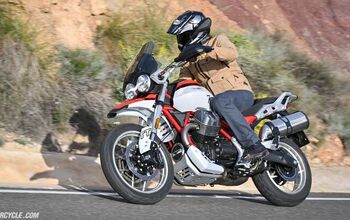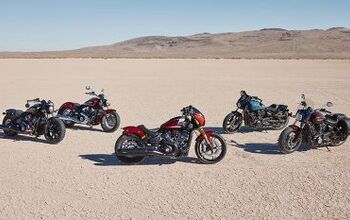Following the Champlain Route - North Bay to Ottawa
Lunch at Average Joe’s Restaurant in North Bay, Ontario was anything but average. From here, we would ride to Ottawa, following the route fur-traders and explorers used four-hundred years ago, well before any Europeans settlements existed in this “new” land. The vista from the lakeside patio called to mind images of how this land must have appeared in those times and the resilient characters who tried to tame it. We too were on an adventure and following the same route, albeit our adventure was of a very different nature.
Mayor Al MacDonald, an avid rider and Harley-Davidson aficionado, warmly welcomed us as we rolled into the parking lot. Although the restaurant’s exterior is non-descript, crossing the threshold takes you into another time. Set on the shore of Trout Lake, the view is gorgeous, peaceful and relaxing – and they serve delicious food as well. The welcome mat is out for bikers and it’s a perfect place to unwind from a morning – or day of riding.
Along with seven motojournalist friends, I was fortunate to experience this slice of Northern Ontario in early June as part of an extended tour of the Ottawa Valley. Ottawa Valley Tourism Association worked with Go Ride Ontario and Trillium Motorcycle Tours and Events to organize a five-day tour through the Ottawa Valley and Algonquin Park. Brand new motorcycles were generously provided by Honda Canada, BMW Motorrad Canada and Deeley Harley-Davidson.
Time has a way of speeding up when pleasant conversation and friendly company are on the menu. However knowing that we still had many miles to cover that day, we reluctantly bid farewell.
North Bay was as far inland as Samuel de Champlain got in 1613, seeking the North West Passage to Asia. The same river system and wilderness he successfully navigated now forms the backdrop for a beautiful motorcycle ride between two modern cities. At 360 kilometers (225 miles), the trip can be done in a single day. However if you want time to soak up the local atmosphere, I’d recommend taking two days and stopping half way in Petawawa for the night.
In the 1600’s, voyageurs on their way inland from Ottawa stopped at the terminus which became North Bay. From here they canoed through the Great Lakes to the Mississippi River. Fast forward to the same setting in 2011. We were navigating a two-lane highway to Ottawa, part of the Trans Canada Highway which stretches from Victoria B.C. to St. John’s Nfld.
As you sit back and enjoy the ride east, it’s easy to let the scenery take you back in time and imagine the harsh conditions through which these early explorers prevailed. The highway follows the Madawaska River to the lumbering town of Mattawa, then bends southeast to parallel the waterway as the Madawaska joins the Ottawa River. Here the valley widens along with the view, creating lovely vistas.
The Ottawa River is one of the most highly regulated rivers in Canada, with over fifty major dams and hydro-electric generating stations scattered along its watercourses. Although well-intended, little was known of their environmental impact when they were erected. A number of these dams are easily visible from the road.
For campers and those who don’t mind riding gravel access roads, several Provincial Parks are easily accessible from the highway. Samuel de Champlain Park just east of North Bay celebrates the voyageurs and the courageous history of the explorer for who it was named. Further along, Driftwood Park has beautiful sandy beaches and hiking trails. Holden Lake, which it’s set on, was formed when Des Joachims Dam was created. Tent and electric campsites are available at both locations. Brent Lake, the northern outpost for world-famous Algonquin Park is also accessed from the highway.
Riding the highway as it threads through the northern towns that crop up periodically, one enjoys vast stretches of uninterrupted riding pleasure. There is a caveat however. As this is the only corridor connecting Ottawa and North Bay along this northern route, traffic can back up, especially given truck traffic and a hilly landscape. Passing zones have been created but its best enjoyed as we did, during off-peak times.
The last ten miles before Petawawa crosses a sand plain zone, formed by an ancient river delta. After passing through seemingly endless forests and rock, it’s surprising to see huge sand cliffs. Home to CFB (Canada Forces Base) Petawawa, one of Canada’s largest military bases, you’ll notice telephone poles alongside the highway low to the ground as the land transitions into a military training area. You’ll also notice yellow ribbons tied to trees and road signs, clear indication of wishes for the safe return of those who are serving.
Here again we received a warm welcome, typical of the hospitality you find in these parts. Waiting to greet us were members of the 1st CAV – Canadian Army Veterans motorcycle unit. They had heard a group of motojournalists was passing through and arranged to greet us. It was an honor to be met by these heroes and a pleasure to share dinner with them at Kelsey’s adjacent to our Inn.
Chain hotels aren’t usually my first choice of accommodation, but the Quality Inn & Suites in Petawawa was lovely and I highly recommend it. Seemingly small touches meant a lot – like allowing us to park under the canopy and being met by the hotel manager. The pretty gift bags waiting in our rooms with an assortment of candies, lip gloss and drug-store sunglasses were a real treat.
The following morning, we were taken by van on a forty-five minute drive down mostly gravel roads and dropped off for a short hike into the Barron Canyon, a breathtaking site within Algonquin Park. Although one of our gals rode in, the riding isn’t favorable for touring bikes. It’s certainly worth the view though and you can arrange transportation through local outfitters.
Before leaving the area, a “must” for our visitors was to sample Poutine, a traditional French-Canadian dish of french-fries topped with cheese curds and beef gravy. Made from fresh ingredients at the local chip-wagon, it was a new culinary treat for my American friends.
There are two main ways to reach Ottawa: continue on the Trans-Canada Highway which becomes multi-lane as it approaches the city; or dip down to some paved sideroads that meander along the Ottawa River. Unless you’re in a big hurry, I’d recommend the latter.
You can access River Road just south of Pembroke by taking the aptly named White Water Road towards Beachburg. From Beachburg, follow Road 21 south to Road 4 and then Road 1 until you reach Arnprior. At this point, it’s most expeditious to get back on Highway 417 for the balance of the trip.
If you’re seeking high adventure, there are a number of whitewater rafting outfits along this stretch of river that also offer accommodations ranging from tent camping and RVing to renovated historical homes. London House Inn and Spa and River Run Rafting are examples. Housed on the same 160 acre property, they have something to suit everyone in the group, whether they prefer to challenge the world-class rapids or relax at the spa.
The valley has widened significantly by this point and the fertile soil supports vast farmlands. When you see the sign for the Mississippi River, don’t look for Tom Sawyer and Huck Finn. It bears no relationship to the mighty American Mississippi that the early voyageurs were seeking, but is part of the massive Ottawa River catchment area. This Mississippi, the Madawaska and others were some+ of the many rivers that supported a booming lumber industry in the mid 1800’s.
In contrast to the countryside we had enjoyed over the previous days, our destination was the beautiful capital city of Ottawa set on the banks of the Ottawa River. With a direct connection to the St. Lawrence River, it drew European explorers inland, convinced they were on their way to Asia. Established as a center of commerce by early settlers caught up in the burgeoning lumber and fur industry, it became the official capital in 1857.
Our last night was spent in grandeur at the historic Fairmont Chateau Laurier, built in 1912 to accommodate well-heeled railway passengers. Here we were, eight women on motorcycles, enjoying that same welcome and attention to detail. How times have changed!
It was a splendid way to end the tour and a fabulous location from which to do a walking tour of a city, rich with history and a palpable pioneer spirit. Now a multicultural, political and busy urban centre, one wonders what aspirations ran through Champlain’s mind as he arrived in the early 1600s at what would have unquestionably been a wilderness outpost.
In any case, it’s a wonderful place to visit. It was the perfect ending to memorable days spent riding with great friends.
Related Reading
Women Riders Tour in Northern Ontario [Video]
Touring Ontario: Exploring the Near North and Rainbow Country
Touring Ontario: Rider-Friendly Accommodations
Top 10 Best Motorcycling Touring Roads
More by Liz Jansen




































Comments
Join the conversation